List of cities and boroughs in Pennsylvania by population
| Rank | City | Population (2015 Census) | County | Motto | Image | Description |
|---|---|---|---|---|---|---|
| 1 | Philadelphia | 1,567,448 | Philadelphia | "Philadelphia maneto" ("Let brotherly love endure") |  |
The largest city in the Commonwealth of Pennsylvania, Philadelphia was founded on October 27, 1682, by William Penn. It is known as the "City of Brotherly Love" because "Philadelphia" is Greek for "brotherly love". It is home to such major league sports teams as the 76ers, Phillies, Flyers, and the Super Bowl LII Champion Eagles. Philadelphia is also home to the monumental Liberty Bell. |
| 2 | Pittsburgh | 304,391 | Allegheny | "Benigno Numine" ("With the Benevolent Deity" also translated as "By the favor of heaven") |  |
Known as the steel city due to the steel factories of the late 19th century and the beginning of the 20th century. Pittsburgh was a huge contributor of steel during World War II, producing 95 million tons of steel. The city is located at the confluence of the Allegheny and the Monongahela Rivers, where they meet to form the Ohio River. While the city is historically known for its steel industry, today it is largely based on healthcare, education, and technology. Pittsburgh is also home to the Pittsburgh Steelers, who have won an NFL-record six Super Bowls, as well as the Pirates and Penguins. |
| 3 | Center City, Philadelphia | 183,240 | Philadelphia | Part of Philadelphia | ||
| 4 | Allentown | 120,207 | Lehigh | "Sic Semper Tyrannis" | 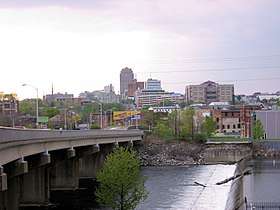 |
Located on the Lehigh River, Allentown is the largest of three adjacent cities that make up a region of eastern Pennsylvania and western New Jersey known as the Lehigh Valley, with the cities of Bethlehem and Easton nearby. Allentown is 60 miles (97 km) north of Philadelphia, 80 miles (130 km) east of Harrisburg, the state capital, and 90 miles (140 km) west of New York City, the nation's largest city. |
| 5 | Erie | 99,475 | Erie | n/a |  |
Named after the Great Lake of the same name, Erie is known as the flagship city because of the presence of Oliver Hazard Perry's flagship Niagara. Erie has also been called the Gem City because of the sparkling lake. Erie is home of the Erie SeaWolves of the Double A Eastern League. The SeaWolves are the Double A affiliate of the Detroit Tigers. |
| 6 | Reading | 87,879 | Berks | n/a |  |
The city lent its name to the now-defunct Reading Railroad, which brought anthracite coal from the Pennsylvania Coal Region to cities along the Schuylkill River. The railroad is one of the four railroad properties in the classic English-language version of the Monopoly board game. During the general decline of heavy manufacturing, Reading was one of the first localities where outlet shopping became a tourist industry. It has been known as "The Pretzel City" because of numerous local pretzel bakeries. It is also known as "Baseballtown," after the Reading Phillies trademarked this moniker to market Reading's rich baseball history. |
| 7 | Upper Darby | 82,795 | Delaware | 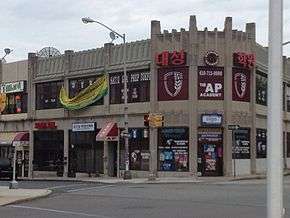 |
Upper Darby Township is a home rule township[1] bordering West Philadelphia in Delaware County, Pennsylvania, United States. Upper Darby is also home to the Tower Theater, a historic music venue on 69th Street built in the 1920s. Upper Darby's population is diverse, representing over 100 ethnic cultures. The township hosts a range of housing types including densely populated rowhouse sections, tree-lined neighborhoods of turn-of-the-century single-family houses and mid-century developments. It is Pennsylvania's sixth most populous municipality. | |
| 8 | Scranton | 77,118 | Lackawanna | "Embracing Our People, Our Traditions, and Our Future" | 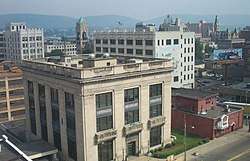 |
Scranton is the geographic and cultural center of the Lackawanna River valley. It is the largest city located in a contiguous quilt-work of former anthracite coal mining communities including the smaller cities of Wilkes-Barre, Pittston, and Carbondale. Scranton was incorporated as a borough on February 14, 1856 and as a city on April 23, 1866. |
| 9 | Bethlehem | 74,892 | Lehigh & Northampton | n/a |  |
Bethlehem lies in the center of the Lehigh Valley, a region of 731 square miles (1,893 km²) that is home to more than 750,000 people. The Valley embraces a trio of cities (Bethlehem, Allentown and Easton) within two counties (Lehigh and Northampton), making it Pennsylvania's third-largest metropolitan area. Smaller than Allentown but larger than Easton, Bethlehem is the Lehigh Valley's second most populous city. |
| 10 | Bensalem | 61,500 | Bucks | %2C_Andalusia_(Bucks_County%2C_Pennsylvania).jpg) |
Bensalem Township is a township in Bucks County, Pennsylvania, United States which borders the northeast section of Philadelphia. The township is composed of many communities, including Bensalem, Trevose, Oakford, Cornwells Heights, Eddington, and Andalusia. As of the 2010 census, the township had a total population of 60,427, which makes it the largest municipality in Bucks County, and the ninth largest in Pennsylvania. The township, which was founded in 1692, is almost as old as Pennsylvania itself, which was founded in 1682. | |
| 11 | Lancaster | 59,339 | Lancaster | n/a |  |
Originally called Hickory Town, now called the red rose city, the city was renamed after the English city of Lancaster by native John Wright. Its symbol, the red rose, is from the House of Lancaster. Lancaster was part of the 1681 Penn's Woods Charter of William Penn, and was laid out by James Hamilton in 1734. It was incorporated as a borough in 1742 and incorporated as a city in 1818. During the American Revolution, it was briefly the capital of the colonies on September 27, 1777, when the Continental Congress fled Philadelphia, which had been captured by the British. After meeting one day, they moved still farther away, to York, Pennsylvania. Lancaster was capital of Pennsylvania from 1799 to 1812, after which the capital was moved to Harrisburg. |
| 12 | Lower Merion | 57,825 | Montgomery |  |
Lower Merion Township is a township in Montgomery County, Pennsylvania and part of the Pennsylvania Main Line. As of the 2010 U.S. Census, the township had a total population of 57,825. Lower Merion has the 5th highest per-capita income and the 12th highest median household income in the country with a population of 50,000 or more.[2] | |
| 13 | Abington | 55,310 | Montgomery | 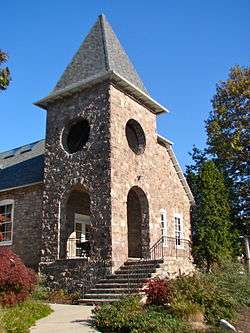 |
Abington Township is a township in Montgomery County, Pennsylvania, United States, adjacent to Philadelphia's northern fringe.[3] The population was 55,310 as of the 2010 census, making it the second most populous township in Montgomery County (following Lower Merion Township). The population density is 3603.3 per square mile, making it the second most densely populated township in Montgomery County (following Cheltenham Township). | |
| 14 | Bristol | 9,631 | Bucks | n/a | 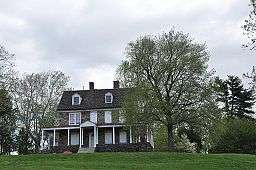 |
Bristol Township is a township in Bucks County, Pennsylvania, United States. The population was 54,582 at the 2010 census, making it the 13th largest municipality in the state. Bristol Township, along with Bristol Borough, is a cultural hub for Lower Bucks County, hosting celebrations of African and Latino heritage. Parts of the township consist of the neighborhoods of Fairless Hills and Levittown, Pennsylvania. |
| 15 | Millcreek | 53,773 | Erie | n/a | 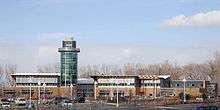 The Tom Ridge Environmental Center |
Millcreek is a township in Erie County, Pennsylvania, United States, within the Erie metropolitan area. The population was 53,773 at the 2016 census. Millcreek is Erie's largest suburb and serves as the gateway to Presque Isle State Park. One of Pennsylvania's largest malls, the Millcreek Mall, is located here on upper Peach Street. Also Waldameer Park, home of the Ravine Flyer which crosses above Peninsula Drive, is located at the entrance to Presque Isle State Park. Also on upper Peach Street is Splash Lagoon an indoor water park. |
| 16 | University City, Philadelphia | 50,967 | Philadelphia | 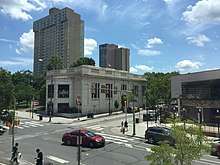 |
Part of Philadelphia | |
| 17 | Harrisburg | 49,081 | Dauphin | n/a |  |
The capital of Pennsylvania, Harrisburg played a notable role in American history during the Westward Migration, the American Civil War, and the Industrial Revolution. During part of the 19th century, the building of the Pennsylvania Canal and later the Pennsylvania Railroad allowed Harrisburg to become one of the most industrialized cities in the Northeastern United States. |
| 18 | Haverford | 48,491 | Delaware | n/a | 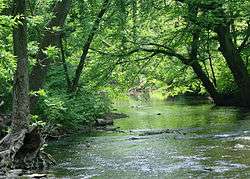 |
Haverford Township (named after the town of Haverfordwest in Wales, UK) is a home rule township[4] in Delaware County—a close-in inner commuting suburb of the city, it is located due west of Philadelphia, in southeastern Pennsylvania, United States, and is officially known as the Township of Haverford. Despite being under a home rule charter since 1977, it continues to operate under a Board of Commissioners divided into wards,[1] as do "First Class" townships that are still under the Pennsylvania Township Code. Haverford Township was founded in 1682 and incorporated in 1911. |
| 19 | Altoona | 45,344 | Blair | n/a | 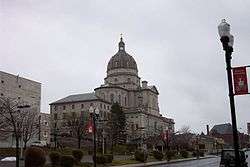 |
Having grown around the railroad industry, the city is currently working to recover against industrial decline and urban decentralization over the past several decades. The city is home to the Altoona Curve baseball team of the Double A Eastern League, which is the Double A affiliate of the Pittsburgh Pirates. |
| 20 | York | 43,992 | York | n/a | York was founded in 1741 by settlers from the Philadelphia region, and named for the English city of the same name. By 1777, most of the area residents were of either German or Scotch-Irish descent. York was incorporated as a borough on September 24, 1787, and as a city on January 11, 1887. During the American Revolutionary War (1775–1783), York served as the temporary capital of the Continental Congress. The Articles of Confederation were drafted and adopted in York, though they would not be ratified until March 1781. It is now called the white rose city. | |
| 21 | State College | 41,992 | Centre | n/a |  |
State College is dominated economically and demographically by the presence of the main campus of the Pennsylvania State University, often referred to as Penn State. Happy Valley is an often-used term to refer to the State College area, including the borough itself and the townships of College, Harris, Patton, and Ferguson.
On home football Saturdays, State College becomes the third largest city in Pennsylvania, with an estimated population over 230,000. State College is known as Thon when the Penn State IFC/Panhellenic Dance Marathon is in season. |
| 22 | Wilkes-Barre | 40,780 | Luzerne | "Pattern After Us" | 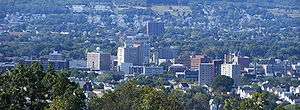 |
Founded in 1769, Wilkes-Barre is the county seat of Luzerne County and is at the center of the Wyoming Valley area. It is surrounded by the Pocono Mountains to the east, the Lehigh Valley to the south, and the Endless Mountains to the west. The Susquehanna River flows through the northwestern portion of the city. |
See also
References
- 1 2 323 Pennsylvania Code § 25.1–101 et seq. Archived 2011-05-27 at the Wayback Machine.
- ↑ https://www.census.gov/quickfacts/table/INC910214/4209144976,00
- ↑ Hoiberg, Dale H., ed. (2010). "Abington". Encyclopædia Britannica. I: A-ak Bayes (15th ed.). Chicago, IL: Encyclopædia Britannica Inc. p. 33. ISBN 978-1-59339-837-8.
- ↑ "323 Pennsylvania Code § 23.1-101 et seq." (PDF). Archived from the original (PDF) on 2011-05-27.
This article is issued from
Wikipedia.
The text is licensed under Creative Commons - Attribution - Sharealike.
Additional terms may apply for the media files.